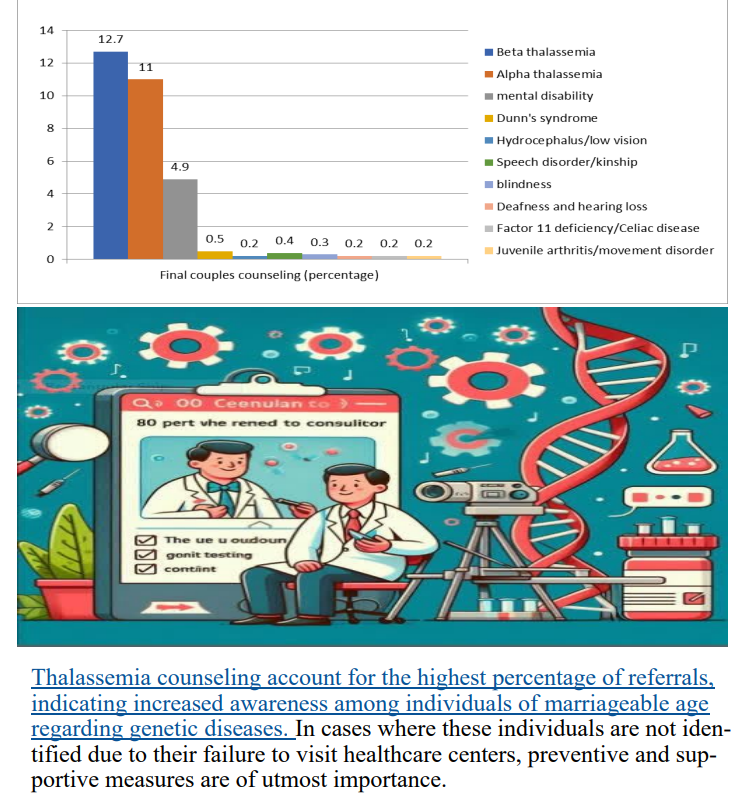Volume 35, Issue 246 (7-2025)
J Mazandaran Univ Med Sci 2025, 35(246): 180-185 |
Back to browse issues page
Download citation:
BibTeX | RIS | EndNote | Medlars | ProCite | Reference Manager | RefWorks
Send citation to:



BibTeX | RIS | EndNote | Medlars | ProCite | Reference Manager | RefWorks
Send citation to:
Geran M, Kashi Z, Khademloo M, Soudmand arshad S, Arab R K, Zarrinkamar M. Frequency Analysis of Genetic Disorders Among Probable Carriers Identified Through Premarital Screening in Behshahr, 2023. J Mazandaran Univ Med Sci 2025; 35 (246) :180-185
URL: http://jmums.mazums.ac.ir/article-1-21416-en.html
URL: http://jmums.mazums.ac.ir/article-1-21416-en.html
Mojgan Geran 
 , Zahra Kashi
, Zahra Kashi 
 , Mohammad Khademloo
, Mohammad Khademloo 
 , Saman Soudmand arshad
, Saman Soudmand arshad 
 , Rogheye Khatoon Arab
, Rogheye Khatoon Arab 
 , Maryam Zarrinkamar
, Maryam Zarrinkamar 


 , Zahra Kashi
, Zahra Kashi 
 , Mohammad Khademloo
, Mohammad Khademloo 
 , Saman Soudmand arshad
, Saman Soudmand arshad 
 , Rogheye Khatoon Arab
, Rogheye Khatoon Arab 
 , Maryam Zarrinkamar
, Maryam Zarrinkamar 

Abstract: (163 Views)
Background and purpose: Premarital care is a global initiative aimed at diagnosing and treating previously unidentified disorders, as well as reducing the transmission of diseases to couples and their children. With the increasing control of infectious and contagious diseases, non-communicable conditions, particularly genetic disorders, have become more prominent. The aim of this study was to investigate the frequency of genetic disorders in probable carriers identified through premarital screening.
Materials and methods: This study employed a descriptive, cross-sectional design. Individuals who visited genetic counselling centers and met the inclusion criteria were conveniently selected for participation. The required information was extracted from the couple records using a data collection form. After collecting the data, the results were analyzed using SPSS version 23. Qualitative variables were described in terms of frequency and percentage.
Results: According to the findings, the most frequently diagnosed conditions among the counselled couples, in descending order, were: thalassemia (12.7%), intellectual disability (4.9%), deafness and hearing loss (2.5%), Down syndrome (0.5%), blindness (0.3%), speech and kinship disorders (0.4%), and hydrocephalus, factor XI deficiency, low vision, celiac disease, juvenile arthritis, and movement disorders (0.8%). Among 1,666 individuals (829 couples) who attended premarital screening, 184 couples (22.1%) required specialized genetic counselling. The primary reason for referral in cases of alpha and beta thalassemia was abnormal laboratory test results. For other genetic disorders, 5% of referrals were due to a personal history of disease in one or both partners, while 95% were based on a family history of genetic conditions.
Conclusion: Thalassemia counselling accounted for the highest percentage of referrals, indicating increased awareness among individuals of marriageable age regarding genetic diseases. In cases where these individuals are not identified because they do not visit healthcare centers, preventive and supportive measures are of utmost importance.
Materials and methods: This study employed a descriptive, cross-sectional design. Individuals who visited genetic counselling centers and met the inclusion criteria were conveniently selected for participation. The required information was extracted from the couple records using a data collection form. After collecting the data, the results were analyzed using SPSS version 23. Qualitative variables were described in terms of frequency and percentage.
Results: According to the findings, the most frequently diagnosed conditions among the counselled couples, in descending order, were: thalassemia (12.7%), intellectual disability (4.9%), deafness and hearing loss (2.5%), Down syndrome (0.5%), blindness (0.3%), speech and kinship disorders (0.4%), and hydrocephalus, factor XI deficiency, low vision, celiac disease, juvenile arthritis, and movement disorders (0.8%). Among 1,666 individuals (829 couples) who attended premarital screening, 184 couples (22.1%) required specialized genetic counselling. The primary reason for referral in cases of alpha and beta thalassemia was abnormal laboratory test results. For other genetic disorders, 5% of referrals were due to a personal history of disease in one or both partners, while 95% were based on a family history of genetic conditions.
Conclusion: Thalassemia counselling accounted for the highest percentage of referrals, indicating increased awareness among individuals of marriageable age regarding genetic diseases. In cases where these individuals are not identified because they do not visit healthcare centers, preventive and supportive measures are of utmost importance.
Keywords: genetic counselling, premarital screening, genetic disorders, consanguineous marriage, intellectual disability
Type of Study: Brief Report |
Subject:
genetic
Send email to the article author
| Rights and permissions | |
 |
This work is licensed under a Creative Commons Attribution-NonCommercial 4.0 International License. |





